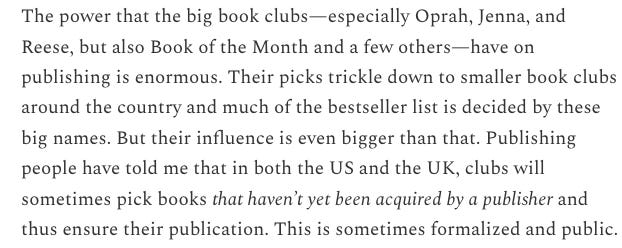Where are the Peggy Guggenheims of Yesteryear?
What if we are the agents now?
PILCROW is Substack’s first serialized novel competition. Each quarter we will present excerpts from the unpublished novels of three rigorously selected finalists, and invite our subscribers to vote on one to be fully serialized on our Substack. Quarterly winners will receive $1,000 and both finalists $500. Our first contest deadline is October 22nd, 2025.
In the summer of 1932, 40 year-old Djuna Barnes was bent to her work: the first draft of what would become her novel Nightwood. Staying the summer at Hayford Hall (“Hangover Hall” to its dipsomaniac habitués) Barnes was the object of Peggy’s considerable largesse, a sort of proto-Guggenheim Fellowship.
Initially rejected by every major publisher, Nightwood is a novel of frank lesbian sexuality and ambiguous politics, written in a cryptic, gothic, high-modernist prose. It’s not merely that the characters aren’t “relatable,” but that the novel is itself about the impossibility of human connection tout court. “For it argues that regardless of sexual orientation, human nature is itself perverted and grotesque, which is why people seek to remake themselves. We are all God’s jokes.”1 Oh, and there’s also the infamous final scene, a phantasmagoric tableau of implied bestiality.
Hardly the “book club fiction”2 that makes contemporary agents twitch in their sleep like dreaming dogs. But in 1936, at the repeated urging of author and poet Emily Coleman – the forgotten member of Barnes’ triumvirate of supporters – T.S. Eliot wrote to Faber & Faber:
“I believe that this may be our last chance to do something remarkable in the way of imaginative literature. This writer is somebody to whom something has happened that happens to very few (because we don’t want it): she has caught up with her own sorrow, identified it and tapped it on the shoulder.. It’s a sorrow much deeper than personal vicissitudes, of course, but it is the sorrow of life, the worm unkillable by any of the agents of this world. And as for her style, it has what is for me the authentic evidence of power, in that I find myself having to struggle, directly after reading, not to ape it myself: and very few writers exercise that pull.”3
In 2025, Peggy Guggenheims and T.S. Eliots are thin on the ground. But more of us are potential Emily Colemans than we might think.
Substack itself is home to the largest concentration of discriminating readers of any single platform. To paraphrase Buckley’s quip about the Boston phonebook: we’d rather entrust the health and dynamism of literary publishing to our first 400 Substack subscribers than the marketing departments of the Big Five.
Much Substack ink is currently being spilled on the harsh realities of literary publishing in our time, some salutary and clear-eyed, some regrettably suggesting a sort of quietism, written in a register to justify the ways of literary poptimism to the grumbling hoi polloi. People have noticed this latter tendency.
One of the former tendency worth reading is Lincoln Michel’s The Book Club Industrial Complex, which usefully de-centers long running debates about MFA culture to point to how the sometimes unpredictable dialectic between superstar influencers and their reading publics dwarfs most intra-literary debates. 4
What is literary Substack, considered in its strange totality, but a cerebrally dyspeptic book club? When will it flex its muscle? To answer that question is why we started PILCROW, where all subscribers will be invited to vote on the novels we serialize in their entirety. Substack can be more than another venue for the perennial plaints and gripes about our hyper-consolidated publishing industry. It can be more than well-read crabs in a bucket. It can be a crucible and a proving ground, a legible democratic assertion that there is still a critical audience for literature for adults.
There’s an entire other post to be written about the role of consolidation in post-war publishing, the rise of the literary agent as arbiter of trend and taste, and the slow extinction of editors like Eliot, Maxwell Perkins, Robert Gottlieb, Toni Morrison, Gary Fisketjon, Nan Talese, et al. In some ways we think that this, especially, represents an unacknowledged psychic wound for many readers and writers: the dissolution of an unspoken social contract wherein — amidst the demands of the accountants — there would still be a happy few influential champions of aesthetic quality, those who cast a wide gaze across American letters, those who could open doors and make careers. Alas, one can’t go home again. But nothing is more American than leaving home and striking out for the territories.
Which way, reader?
Herring, Phillip F. Djuna: The life and works of Djuna Barnes. (New York: Viking, 1995), 207
Though it’s true Romantasy readers are not immune to the enduring psychoanalytic potencies of bestiality.
Ibid., 230
Worth remembering is the fact that the subcultures of fan-driven genre fiction never forgot how to embrace the serialized novel form, nor the market power of demonstrated reader enthusiasm. The tangible result is the front table at your local chain bookstore.



